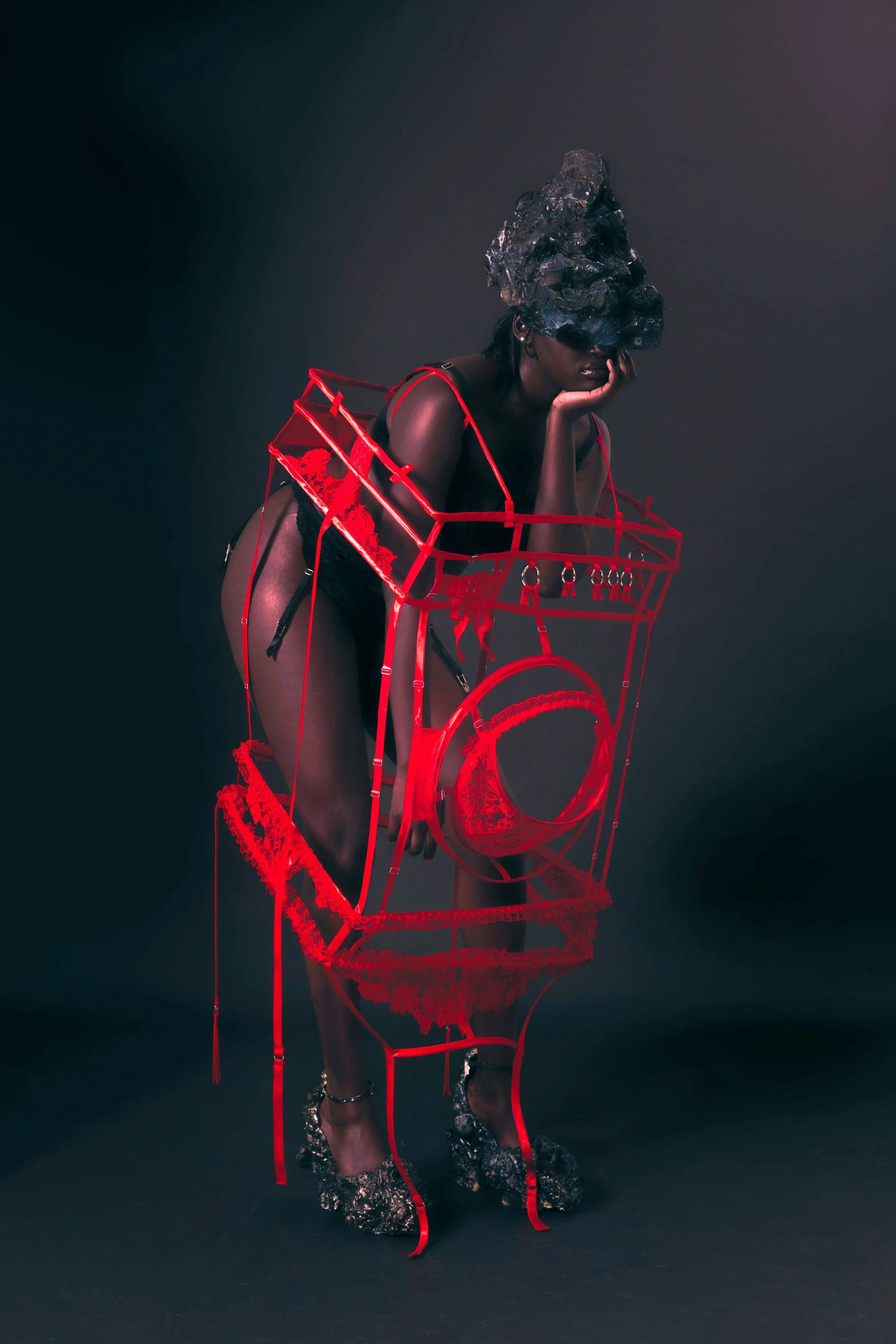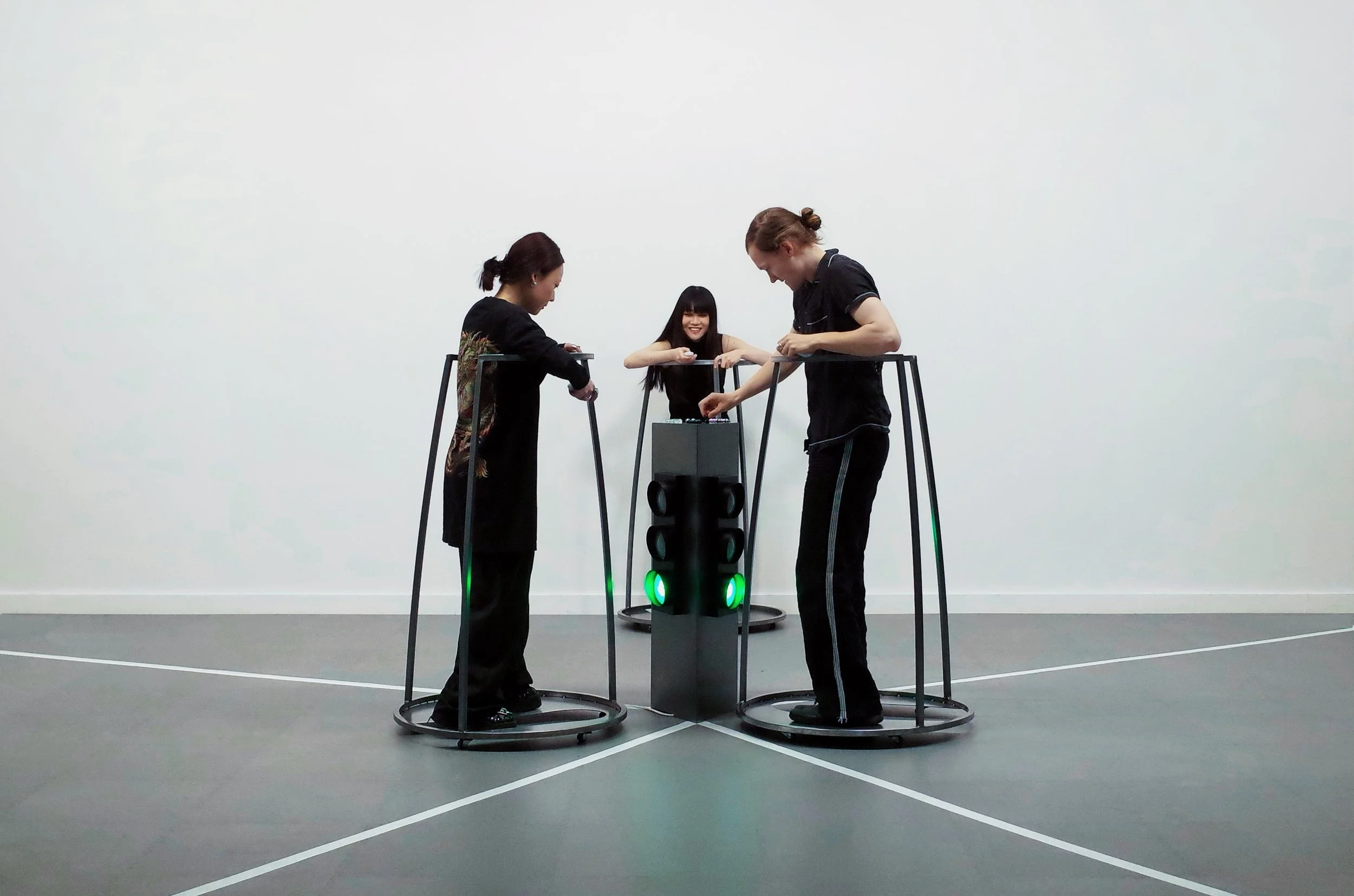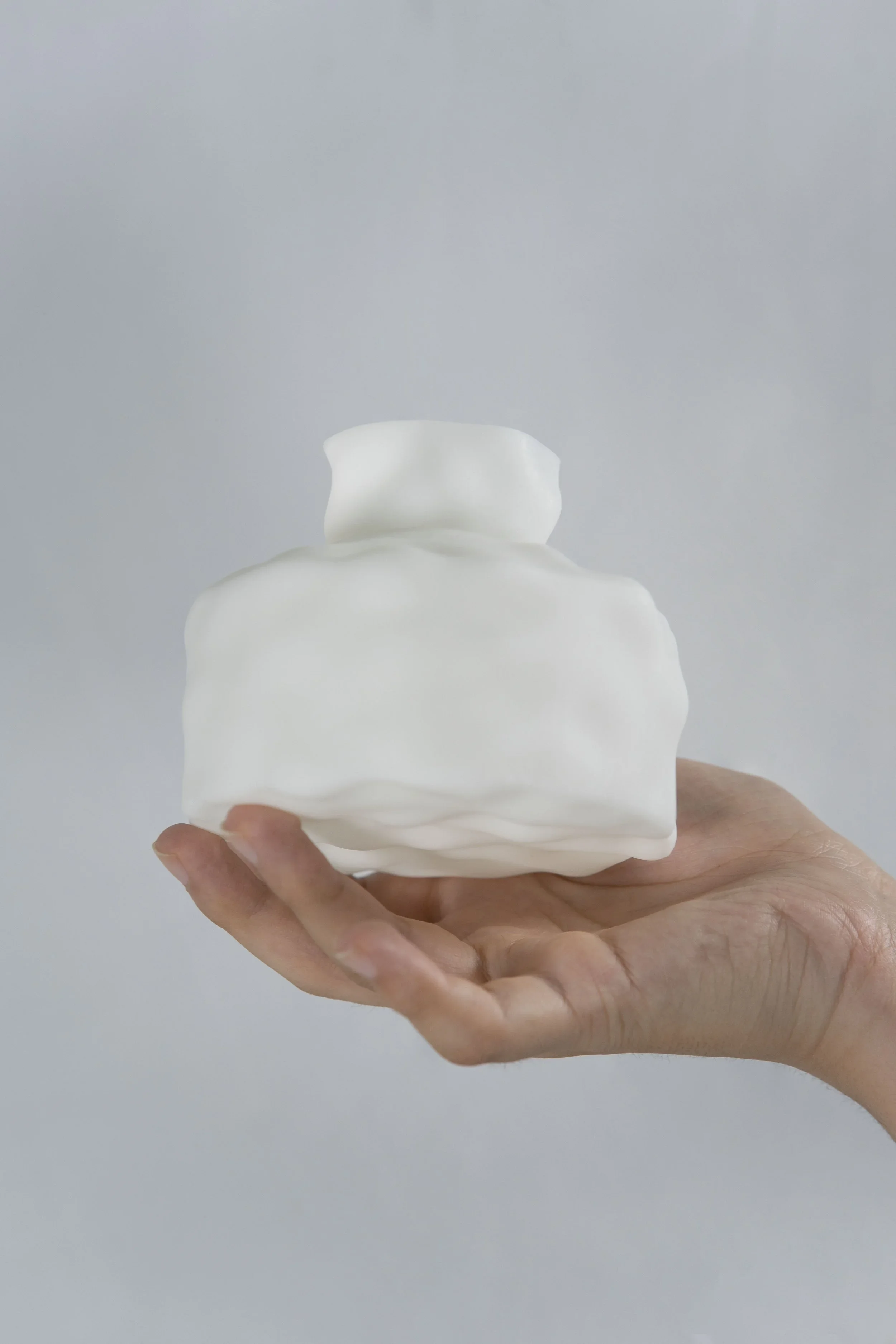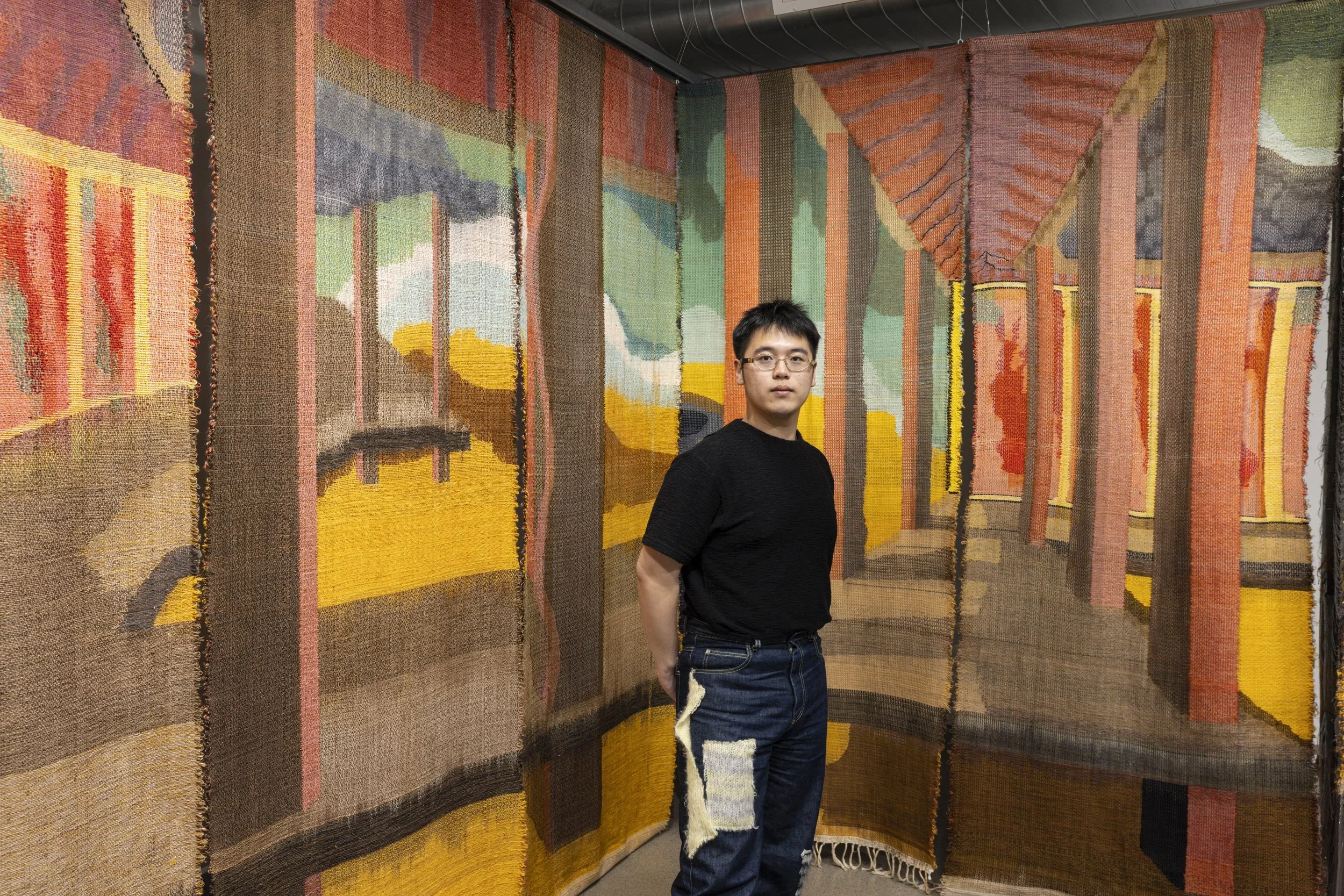10 Questions with Angel Jiaqi Qin
Angel Jiaqi Qin is a post-human image weaver. Having lived and studied in Rochester, New York, Beijing, and London, Angel's practice seeks out an exploration of disruptions in the otherwise straight, smooth, and flat narratives. She weaves patterns of imagery from a non-human-centric perspective, questioning the ontological nature of humanity and its relationship with ecology. She began her academic journey with a Bachelor's degree in Film and Media Studies from the University of Rochester. Her diverse studies, which included minors in Studio Arts, Japanese, and Environmental Humanities, laid the groundwork for her interdisciplinary approach to art. Angel furthered her expertise by pursuing a Master's in Contemporary Art Practice at the Royal College of Art in London, focusing on Moving Image, which allowed her to delve into conceptual and performative arts. Angel's multifaceted approach integrates digital media, fashion, and performance to probe the dynamic interplay between humanity, ecology, and technology.
Angel's art invites a reimagining of human identity amidst techno evolution, advocating for harmony with nature and a nuanced understanding of our digital coexistence. Her work has been featured in Frieze Magazine and Vogue Italy, and she has performed at Tate Modern.
Angel Jiaqi Qin - Portrait
ARTIST STATEMENT
Angel's art invites a reimagining of human identity amidst digital evolution, advocating for harmony with nature and a nuanced understanding of our digital coexistence. Through her creative endeavors, Angel urges a reevaluation of our interconnectedness in the digital and natural worlds, making a significant statement on contemporary human identity.
In her artistic practice, Angel engages in interventions that displace objects from their conventional contexts, deconstructing their typical symbolic meanings to provoke reflection on their role within the environment. This method is exemplified in her performance piece "Niwa," where she arranged traditional Japanese ikebana on a toilet, thereby challenging conventional notions of aesthetics and utility. Similarly, in her interactive project "Humanware," Angel transformed human chromosomes into binary codes to explore the concept of digital gender identity, examining the intersections of technology, biology, and personal identity.
Her work is deeply infused with a post-humanist ethos, employing technology and biology to explore the concept of symbiosis as a dynamic equilibrium. This perspective is vividly illustrated in projects such as "Humanware" and "White Euphoria," where Angel designs lingerie for household appliances, challenging traditional distinctions between the organic and inorganic, as well as the utilitarian and the ornamental. By adorning commonplace appliances with intimate apparel, she blurs the boundaries between human and machine, fostering a dialogue about our evolving relationship with technology.
Angel's interventions are not merely artistic expressions but deliberate efforts to transform perceptions of the physical, social, and psychological environments. Through her work, she strives to articulate experiences and emotions that are often intangible and indescribable, challenging viewers' perceptual boundaries. Her art aims to demonstrate and reimagine the coexistence between humans and non-human entities, advocating for a non-anthropocentric view of life that deepens our understanding of symbiosis in the contemporary world.
White Euphoria (AirConditioner), Installation, 90x30x20 cm, 2023 © Angel Jiaqi Qin (Photo by Xinyuan Yan and Xiao Guo)
INTERVIEW
You define yourself as a "post-human image weaver." Can you tell us more about this definition? And what does it mean for you and your practice?
Defining myself as a "post-human image weaver" showcases my artistic practice of delving deeply into and reinterpreting images and media. In this definition, "weaving" is not only a technical approach but also a philosophical contemplation. This weaving process is not just about layering images or moments in time but also about deconstructing and deeply reflecting on existence itself.
Weaving is a process of deconstruction. When you weave something, it's in the state of "becoming". It is thus a reflection on objects and their states of being. It also demonstrates my pursuit of open-ended narratives rather than closed ones, resisting traditional visual and narrative structures. This openness reflects my exploration of post-human themes, particularly in the context of the increasingly blurred boundaries between technology and humanity, where I use art to explore these complex networks of relationships.
Weaving is also a practice of creating "folds." In my work, I generate folds by distorting and reconfiguring images and symbolics, which not only resists the physical smoothness but also challenges the standardized shapes produced by modern industry and capitalism, as well as standardized screen ratios. The use of distortion and folds reveals the complexity and deep structures behind these surfaces, encouraging viewers to shift from passive recipients of information to active participants and interpreters.
As a "post-human image weaver," my artistic practice focuses on challenging and expanding our perception and understanding of reality through visual art. Through this approach, I aim to initiate dialogues and explore the new relationships between humans, machines, and the environment in an era of rapid technological advancement. This practice is not just about creating images but is a process of critiquing and reimagining existing social and cultural structures.
Let's talk about your academic background. How did your studies in Film and Media Studies, Studio Arts, Japanese, and Environmental Humanity influence your artistic journey?
For me, my academic journey reflects the "roots" and "texture" of my artistic practice. The study of Environmental Humanity is at the core of my practice. My artistic journey involves exploring self-identity through an ecological perspective and reframing the environment from various dimensions serves as a way to probe ontological questions about the self. In Film and Media Studies, I delve into narrative and visual storytelling methods, enabling me to construct and deconstruct environmental narratives in ways that challenge traditional views. Studio Arts offer me opportunities to materialize thoughts on the environment and humanity through sculpture and installations.
The study of Japanese has profoundly influenced the texture and essence of my work. Whether at the visual or conceptual level, I am subtly influenced by Zen, often leaving ample space for emptiness and imagination in my work. Elements of Zen are strongly present in my pieces, such as the stone headgear and floral arrangements in toilets found in "White Euphoria." These elements represent a meditation on tranquility, a synesthetic tone and flavor reminiscent of winter's snow, and a warm cup of tea.
White Euphoria (AirConditioner), Photography, 2023 © Angel Jiaqi Qin (Photo by Xinyuan Yan and Xiao Guo)
At the same time, you lived and studied in different places, such as Rochester, New York, Beijing, and London. Did these experiences influence your artistic practice and perspective?
For me, cultural experiences have infused a unique "humidity" into my artistic creation. This "humidity" not only represents the essential conditions of my growing environment but also symbolizes how I, as an artist, observe and understand the world—it permeates every piece of my work as an underlying tone. Although I am from China, I have lived in the UK and the USA for six years and devoted five years to studying Japanese language and culture. These diverse cultural experiences have profoundly shaped my artistic expression.
Growing up in big cities has made my life experience in Rochester particularly unique. The pace of life in Rochester is much slower than in large cities, allowing me to immerse myself more deeply. Rochester is well-known for its greenery and emphasis on environmental protection. For instance, a highway I frequently used to travel to school was deliberately built around a tree to preserve it. It was in Rochester that I was deeply influenced by the teachings of Professors Leila Nadir and Cary Adams on ecological philosophy, which have become the core of my artistic practice. This city is intimately connected with my artistic endeavors. In contrast, although the urban life in New York, Beijing, and London differs from one another, each city has contributed to my understanding of global cultural dynamics and the complex interweaving of tradition and modernity.
In my pieces, the influence of Chinese and Japanese culture manifests as a form of Eastern philosophical thinking. Meanwhile, Western education has endowed me with a pursuit of avant-garde styles, bringing courage and a capacity for critical thinking. The "humidity" and energy brought by these different cultural backgrounds have together nurtured each of my artworks.
Your practice incorporates digital media, fashion, and performance to probe the dynamic interplay between humanity, ecology, and technology. Can you elaborate on how these elements come together in your work?
In my artistic practice, I approach from a post-human perspective to explore questions about my own ontology. Fashion and performance art are closely linked to my corporeality, each representing an exploration of my own skin and the kinetic energy of my limbs. Digital media, on the other hand, represents a post-human perspective and exploratory environment, where my skin is viewed as pixels and my limbs as direct interactions with electric currents.
For instance, in my work "Humanware," I digitalize human imagery and create a dress-up game. This not only demonstrates how digital media can transform the human body into an interactive virtual existence but also explores the dynamic relationship between the body and digital interfaces. Through this, I aim to challenge traditional perceptions of the physical body and prompt viewers to reconsider the identity and existence of humans in a technology-driven world.
In utilizing fashion and performance art, I explore and express the boundaries of the body through design and performance. These forms of expression are not only explorations of physical existence but also philosophical inquiries into the essence of life activities. By integrating these elements into my artistic practice, I am able to discuss the post-human theme from multiple dimensions, providing the audience with a new perspective to perceive and experience the complex interplay between humanity, ecology, and technology.
White Euphoria (Fridge), Installation, 180x90x45 cm, 2023 © Angel Jiaqi Qin (Photo by Xinyuan Yan and Xiao Guo)
White Euphoria (Microwave), Photography, 2023 © Angel Jiaqi Qin (Photo by Xinyuan Yan and Xiao Guo)
Could you describe your creative process from conceptualization to completion for one of your projects?
In White Euphoria, I want to offer a joyful offense to the burnout quotidian through a fetish gaze toward domestic appliances.
In the design, I used lace and classic sexy lingerie colors to generate a fetish feeling while retaining the original straight and square silhouette of the appliance's body. In addition, in each lingerie, I have integrated the partial erotic elements of human lingerie, such as bras, waistbands, and suspenders for stocking. In order to deliver a feeling of post-human hybrid, a mishmash between a human's curvy body lines and the machine's straight and clear contours.
This fetishistic gaze embodies the production of desire in a capitalist society.
From my perspective, Capitalist society produces smooth and straight frames, while resisting the generation of folds. Our Everyday Life is also alienated and colonized by consumerism. It becomes a linear rhythm, the product of homogeneous and quantified repetitive quotidian, which in turn breeds a sense of burnout.
On the other hand, this project also points to a kind of hybrid, which I expressed through fashion photography. Home appliances are like the vegetative nervous system in our domestic living space. They function independently of consciousness and regulate the basic physiological activities of the body's internal organs, such as breathing and heartbeat, to maintain the most basic instincts of life.
Designing underwear for machines is in itself a vibrant creative impulse. This work thus points to another, more mysterious facet: Eroticism is revealed in the folds of lace, liberating these bodies from the smoothness and revealing their inner Libido - a vigorous primal drive for life.
How do you believe your interdisciplinary approach to art contributes to exploring disruptions in human-centric narratives and the relationship between humanity, ecology, and technology?
My interdisciplinary approach to art significantly enriches the way I explore disruptions in human-centric narratives and the relationship between humanity, ecology, and technology. By integrating learning from various disciplines, I can examine and understand a theme from multiple perspectives, employing a diverse range of thinking and narrative techniques.
For example, my background in film studies introduced me to the technique of montage, which not only inspired me to break away from traditional linear narratives but also challenged the anthropocentric tendencies in historical narratives. Linear narratives often emphasize the continuity and logic of human experience, whereas montage allows me to reorganize time and space in a nonlinear fashion, revealing the complexity and diversity hidden behind everyday experiences and historical events.
Furthermore, my study of Japanese culture has deepened my understanding of Shinto's animism, which views all things as having spirits just like humans. This belief significantly influences my artistic expression related to ecology and technology, driving me to explore the interrelations and balance between humans, the natural world, and the broader technological environment. Through this perspective, I aim to break away from the traditional human-centered worldview and explore a more comprehensive and harmonious symbiotic relationship.
Your work advocates for harmony with nature and a nuanced understanding of our digital coexistence. How do you see art's role in raising awareness and promoting change in these areas?
I believe that, compared to other media, art is a more intuitive way of creating "images." Through visual means, art can implant images into people's consciousness. This approach is different from direct political viewpoints or explicit assertions; it is more like a gentle sowing. In my view, the right to interpret art coexists with the audience, allowing individuals to understand art based on their personal experiences and integrate these images into their own consciousness. Therefore, I consider art to be extremely important. Particularly in the realms of nature and digital technology, I believe that art can awaken a deeper awareness of the beauty of nature and the impacts of technology. Art not only reveals the interactions between nature and the digital world but also challenges our everyday perceptions of these interactions, encouraging us to reevaluate and form new understandings of ecological environments and the integration of technology. In this way, art becomes a powerful tool for communication, enhancing our appreciation for coexistence in harmony and delving into the complexities of our digital cohabitation. It serves not only as a platform for expression and reflection but also as a crucial force in promoting environmental awareness and discussions on technological ethics.
White Euphoria (Washing Machine), Installation, 80x60x40 cm, 2023 © Angel Jiaqi Qin (Photo by Xinyuan Yan and Xiao Guo)
White Euphoria (Washing Machine), Photography, 2023© Angel Jiaqi Qin (Photo by Xinyuan Yan and Xiao Guo)
Is there any other medium or technique you would like to implement in your production or explore in your artistry?
In my future artistic explorations, I am particularly interested in integrating neuroscience into my art creation. For example, I plan to use eye-tracking technology to detect the visual focus of the audience and, based on this data, create uniquely woven fabrics. This technology not only captures the visual behavior of viewers but also enables the creation of distinctive artworks based on these insights. Additionally, I plan to collaborate with the aerospace sector, utilizing planetary data and observational technologies for what I call "cosmic archaeology." Through these projects, I aim to further promote and expand the interdisciplinary applications of art and break existing visual aesthetic paradigms.
Do you have any new projects or series you are currently working on?
I'm currently developing a series of video-weaving swatches. In this project, I repurpose 'digital waste' from discarded smartphone images to craft a type of electronic video fabric. I treat the videos as sculptures or fabrics of time by applying wrapping distortions, thereby attempting to reveal their textures and emphasize the fetishization and destruction of the smooth surfaces of digital imagery.
The act of making images move is akin to sewing moments together. Recording is like manually cutting out a piece of fabric from the world, while editing is like continuously adjusting images wrapped around a loom. These processes expose the threads beneath the smooth surfaces, pulling an event into strands of yarn and then re-weaving them into a new form. The events are deconstructed by the framing of camera positions, timelines, edits, and screens. This deconstruction also breaks down the attention and scrutiny they are subjected to. Focusing on the frames causes the original boundaries to dissolve while simultaneously creating new ones. The emphasis on deconstruction serves as an emphasis on creation, reflecting on the very state of existence of the images. A segment of the video is sealed, containing a segment of 'dead' time. Through weaving, I aim to open up its closed nature, inviting a reconsideration of time and perception in our digital age.
Lastly, where do you see yourself and your art five years from now?
Over the next five years, I plan to continue promoting interdisciplinary collaborations between art and other fields, particularly combining art with science, technology, and environmental studies. My goal through these collaborations is to explore the potential of art in addressing global challenges such as climate change. I believe that art can not only enhance public awareness of environmental crises but also inspire society to think about the framing of ecology.
Specifically, I aim to initiate projects on recycling intangible digital waste generated by emerging technologies, as well as conducting academic gender studies related to digital files. By visualizing scientific data, I plan to expand and deepen the public's understanding of environmental issues. Furthermore, I intend to conduct more in-depth studies on the ecological impacts of electronic products and new technologies. Through these efforts, I hope to leverage the power of art to foster societal recognition and action toward the understanding of ecology.
Artist’s Talk
Al-Tiba9 Interviews is a promotional platform for artists to articulate their vision and engage them with our diverse readership through a published art dialogue. The artists are interviewed by Mohamed Benhadj, the founder & curator of Al-Tiba9, to highlight their artistic careers and introduce them to the international contemporary art scene across our vast network of museums, galleries, art professionals, art dealers, collectors, and art lovers across the globe.






















